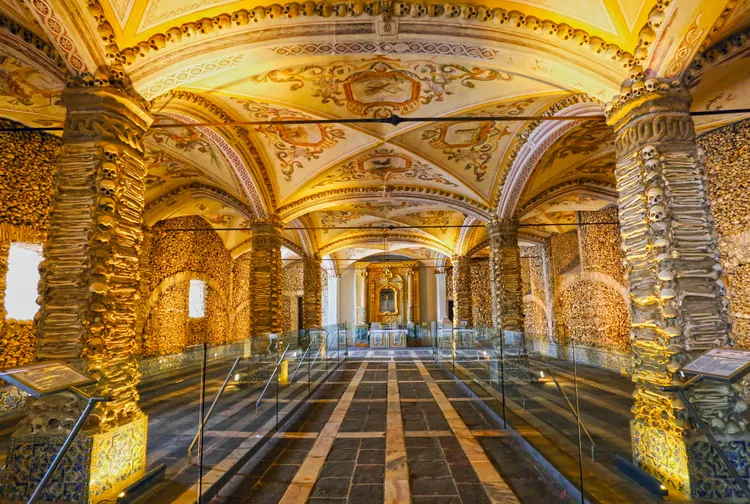Around an hour and a half from Lisbon, Evora is an enticing destination for both Portuguese and international travelers. The city’s culinary delights are its major attraction; both Evora and the broader Alentejo region are famed for exceptional food and wine.
However, Evora offers much more than its gastronomy. The compact downtown features numerous architectural and cultural highlights, with the most notable being a rather ghastly site. The Capela dos Ossos, or “Chapel of Bones,” is home to thousands of human bones stacked high from floor to ceiling along every wall of this small chapel.
This chapel is often a must-see for many tourists. Therefore, if you plan to visit while in town, here is everything you need to know.
1. Background
The chapel dates back to the 16th century, when local church leaders faced a significant challenge. The nearby cemeteries were becoming overcrowded, encroaching upon valuable land near the city. Consequently, a decision was made to relocate the bones of the deceased to a dedicated chapel.
Rather than hide the bones away, the monks aimed to use this as a teachable moment. They desired that visitors would contemplate their mortality and adjust their behavior accordingly during their lifetimes.
The outcome of this approach remains unclear, yet the result is the Capela dos Ossos we see today. Over 5,000 bones are meticulously stacked, filling nearly every possible inch of space. Notably, a pair of nearly-complete skeletons can be spotted hanging from the walls, adding a particularly macabre touch.
To ensure that medieval visitors grasped the message clearly, the inscription “Nós ossos que aqui estamos, pelos vossos esperamos” (“we, the bones that are here, await yours”) was engraved above the entrance and continues to be displayed today.
2. How to Visit
Evora’s Chapel of Bones is connected to the Igreja de São Francisco, a gleaming white church located at the heart of the town. The entrance is prominently marked to the right of the main church doors.
The chapel remains closed on Sundays, January 1, Christmas Eve afternoon, and Christmas Day. From June 1 to September 1, the chapel operates from 9 a.m. to 6:00 p.m. During the rest of the year, it closes at 5:00 p.m., and on Saturdays, it closes at 1:00 p.m. Furthermore, like many attractions in Evora, daily closures for lunch occur on weekdays between 1 p.m. and 3:00 p.m., necessitating careful planning for visits.
An adult ticket is priced at €2, with an extra €1 fee for photography.
The chapel’s compact size means that visitors shouldn’t expect to spend a long time there. For those without a specific interest in historical bones, about 10-15 minutes will likely suffice. Depending on the timing of your visit, the wait in the ticket line may actually exceed the time spent inside the chapel itself!
3. What Else to See Nearby
Once you’ve completed your tour of the chapel, don’t miss the church’s museum, which is included with your ticket. While it lacks human remains, it compensates with an impressive collection of religious paintings, sculptures, and other artworks from the convent.
Less than a ten-minute stroll away, situated at the highest elevation in the vicinity, lies Evora’s cathedral. Ticket prices range from €2 to €4.50, depending on the sections you wish to explore, with the highlight being panoramic views of the city from the cathedral roof, especially on sunny days.
Adjacent to the cathedral is the templo romano de Évora, the remnants of a Roman temple dating back to approximately the first century AD. After being destroyed by invading forces in the fifth century, it served various purposes over the years, including functioning as a butcher shop, before restoration work began in the 1870s. The ruins are situated on a raised platform in a public square and are accessible to all at no charge.





